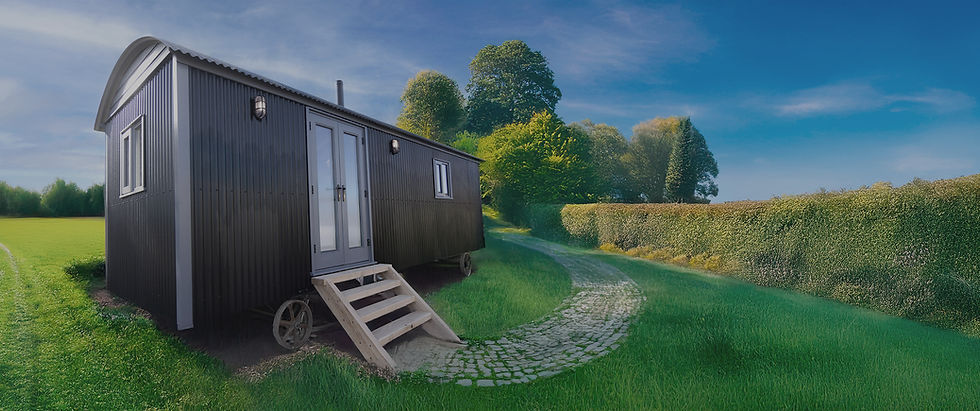What Is a Shepherd’s Hut?
- Kerri Cuthbert

- May 22
- 5 min read
Updated: Jun 17
Shepherd’s huts are a beloved part of British countryside heritage—compact, wheeled structures that have evolved from humble beginnings into luxurious, versatile outdoor rooms. But what exactly is a shepherd’s hut, and why are they making such a big comeback across the UK?
In this guide, we’ll explore the history of shepherd’s huts, their traditional features, how they’re used today, and what makes them such a desirable addition to modern living. Whether you’re looking to enhance your garden, start a glamping business, or create a cosy studio, this article is here to help you understand the charm and value of a shepherd’s hut.

A Brief History of Shepherd’s Huts in the UK
Shepherd’s huts date back to at least the 16th century and were originally built as mobile field shelters for shepherds during lambing season. These early huts were designed to be practical, weatherproof, and towable—allowing shepherds to stay close to their flocks in all conditions.
Typically, a traditional shepherd’s hut featured a curved corrugated roof, cast-iron wheels for mobility, timber walls, and a small wood-burning stove to provide warmth. The interior layout was compact but purposeful: a simple bed, a small workbench, and storage space for tools, feed, and lambing equipment.
Their use peaked in the 19th and early 20th centuries, particularly as flock sizes increased and shepherds needed to work further afield. With the rise of modern farming equipment, the huts gradually fell out of use—but many originals still exist across the British countryside, often restored as charming outbuildings.
Today, the shepherd’s hut has made a striking return. Blending rustic heritage with modern craftsmanship, these structures are now used for everything from glamping pods to garden studios.
Learn more about the history of shepherd's huts.
Traditional Design and Features
Traditional shepherd’s huts were built with function at the forefront. Designed to be mobile, weatherproof, and compact, every detail served a purpose for shepherds working in often remote and exposed conditions.
Here are some of the classic features found in historic UK shepherd’s huts:
Cast-Iron Wheels – Allowed the hut to be moved easily across fields.
Curved Corrugated Roof – Offered durable, weather-resistant protection and extra headroom.
Timber Frame & Cladding – Usually wooden, though later huts sometimes used metal for added durability.
Wood-Burning Stove – Essential for warmth and basic cooking.
Stable Door – Provided ventilation and visibility while keeping out draughts and animals.
Compact Interior – Cleverly arranged with a bed, shelves, and workbench for living and lambing duties.
While each hut could vary slightly depending on the region or builder, the emphasis was always on practicality, mobility, and protection in the field.
Modern Interpretations and Uses
While shepherd’s huts began life as simple, mobile shelters for livestock keepers, their charm and practicality have led to a surge in popularity across the UK for all sorts of contemporary uses.
Today’s huts combine traditional craftsmanship with modern comforts, making them ideal for a wide range of purposes, such as:
Glamping Pods - Now a favourite in the UK’s glamping scene, shepherd’s huts offer a cosy, stylish alternative to tents—with proper beds, wood burners, and even en-suites.
Garden Offices or Studios - Perfect for remote working or hobbies, huts make quiet, comfortable workspaces right at home.
Guest Rooms - A private space for visitors—or a charming holiday let for extra income.
Wellness Rooms - Ideal for saunas, massage spaces, or yoga retreats, thanks to their snug, insulated design.
Pop-Up Shops or Event Spaces - Great for festivals and markets—these eye-catching huts are used as cafés, retail units, and more.
Modern shepherd’s huts can be fitted with insulation, electricity, plumbing, and bespoke interiors, making them comfortable and usable all year round. Whether for personal use or business, they offer a flexible, low-footprint solution with timeless character.
Read more about how people use shepherd’s huts today in our guide: What’s a Shepherd’s Hut Used For?
Why Choose a Shepherd’s Hut?
Shepherd’s huts have grown in popularity across the UK for good reason. They offer a practical, stylish, and flexible solution for those looking to enhance their outdoor space.
Here’s why investing in a shepherd’s hut could be the ideal choice:
Incredible Versatility: Use it as a garden office, creative studio, guest accommodation, or even a profitable holiday let – the possibilities are endless.
Fully Mobile: Unlike traditional buildings, shepherd’s huts can be moved easily. No need for permanent foundations means fewer planning restrictions and more flexibility.
Charming Design: With their blend of rustic character and modern comforts, shepherd’s huts offer timeless appeal that suits both countryside and contemporary settings.
Space-Saving Solution: Designed to make the most of compact outdoor areas, they provide a cosy yet functional living or working environment without taking over your garden. For modern adaptations and space-saving solutions within shepherd's huts, consider exploring Arbor Shepherd Huts' guide on making the most of your shepherd hut.
Whether you're creating a peaceful garden retreat or launching a glamping business, a shepherd’s hut is a unique and sustainable choice that brings historical charm into modern living.
Visual Inspiration
Explore our gallery of beautifully crafted shepherd’s huts to envision how one could enhance your outdoor space.
Discover Your Perfect Shepherd’s Hut
At Tiny Homes, we specialise in designing and building bespoke shepherd’s huts tailored to your needs. Our huts are constructed using sustainable materials and traditional craftsmanship, ensuring quality and longevity.
Contact us today to learn more about our offerings and how we can help bring your vision to life.
Expand Your Shepherd’s Hut Knowledge
FAQs
What is a shepherd’s hut used for today?
Modern shepherd’s huts are used for everything from home offices and guest rooms to glamping accommodation and wellness spaces. Their versatility makes them ideal for both personal and commercial use.
Are shepherd’s huts suitable for year-round use?
Yes, contemporary shepherd’s huts are typically well-insulated and can be fitted with heating, plumbing, and electricity—making them comfortable to use all year round.
Can I move my shepherd’s hut to a different location?
Yes, one of the key advantages of a shepherd’s hut is its mobility. Equipped with wheels and a tow bar, it can be relocated using a suitable vehicle, allowing flexibility in positioning or moving to a new property.
What maintenance is required for a shepherd’s hut?
Regular maintenance includes checking and treating wooden components to prevent rot, inspecting roofing materials, and servicing any installed utilities. With proper care, a well-built shepherd’s hut can last for several decades.
Whether you're drawn to their nostalgic charm, looking for a creative way to expand your living space, or considering a unique business opportunity, shepherd’s huts offer a beautifully simple solution. With their roots in rural tradition and their place in modern design firmly established, it’s no wonder they’ve become a popular choice across the UK.
Ready to start your own shepherd’s hut journey? Explore our range, get inspired, and discover how this timeless structure can bring both style and purpose to your outdoor space.





















Comments